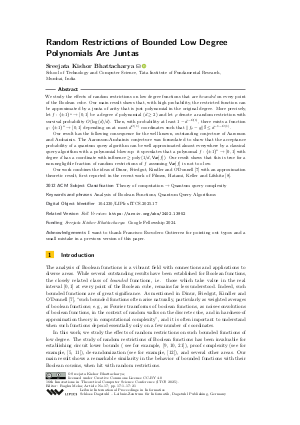LIPIcs.ITCS.2025.17.pdf
- Filesize: 0.77 MB
- 21 pages

 Creative Commons Attribution 4.0 International license
Creative Commons Attribution 4.0 International license

We study the effects of random restrictions on low degree functions that are bounded on every point of the Boolean cube. Our main result shows that, with high probability, the restricted function can be approximated by a junta of arity that is just polynomial in the original degree. More precisely, let f: {± 1}ⁿ → [0,1] be a degree d polynomial (d ≥ 2) and let ρ denote a random restriction with survival probability O(log(d)/d). Then, with probability at least 1-d^{-Ω(1)}, there exists a function g: {± 1}ⁿ → [0,1] depending on at most d^O(1) coordinates such that ||f_{ρ}-g||_2^2 ≤ d^{-1-Ω(1)}.
Our result has the following consequence for the well known, outstanding conjecture of Aaronson and Ambainis. The Aaronson-Ambainis conjecture was formulated to show that the acceptance probability of a quantum query algorithm can be well approximated almost everywhere by a classical query algorithm with a polynomial blow-up: it speculates that a polynomal f: {± 1}ⁿ → [0,1] with degree d has a coordinate with influence ≥ poly(1/d, Var[f]). Our result shows that this is true for a non-negligible fraction of random restrictions of f assuming Var[f] is not too low.
Our work combines the ideas of Dinur, Friedgut, Kindler and O'Donnell [Dinur et al., 2006] with an approximation theoretic result, first reported in the recent work of Filmus, Hatami, Keller and Lifshitz [Yuval Filmus and Hamed Hatami, 2014].

Feedback for Dagstuhl Publishing